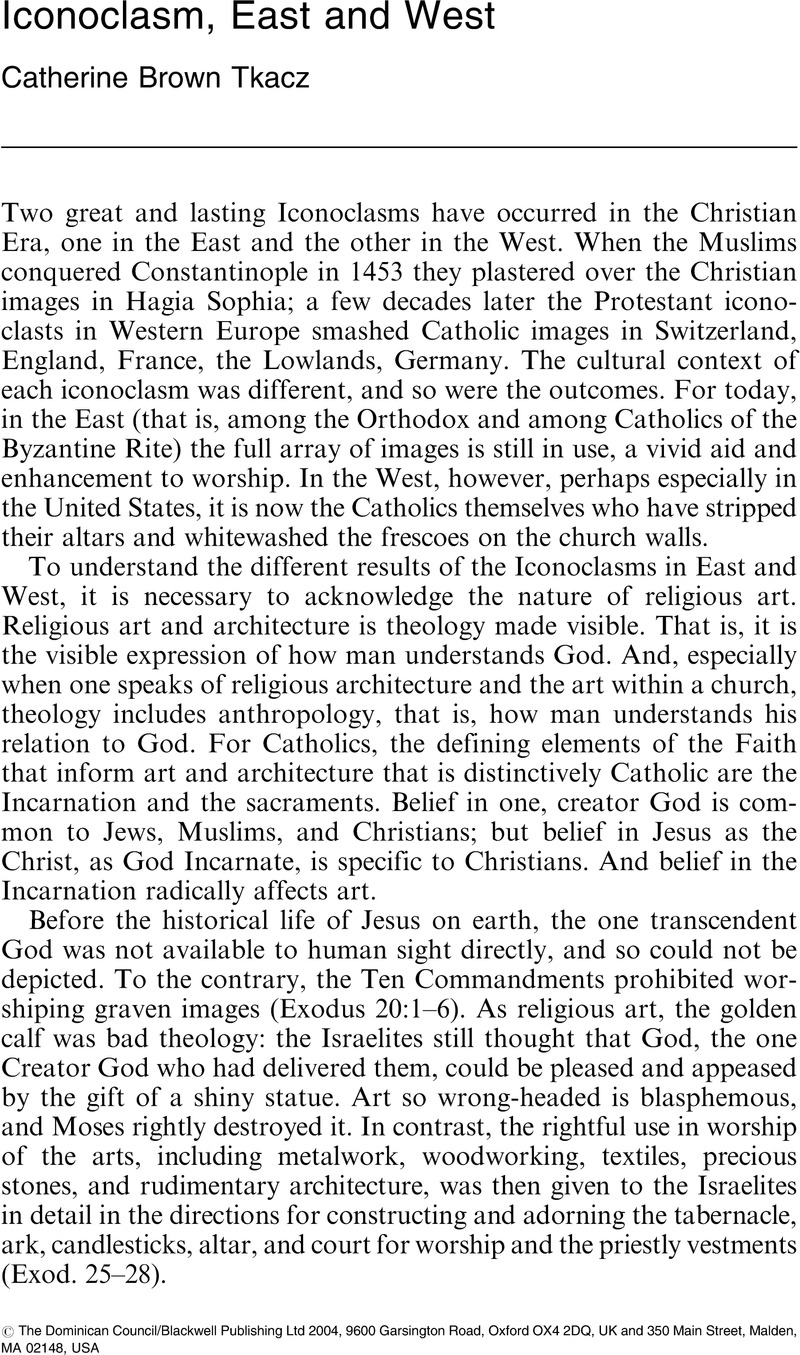Article contents
Iconoclasm, East and West
Published online by Cambridge University Press: 01 January 2024
Abstract

- Type
- Original Articles
- Information
- Copyright
- Copyright © The Dominican Council/Blackwell Publishing Ltd 2004
References
1 Catechism of the Catholic Church, 2nd ed. (Cittá del Vaticano: Libreria Editrice Vaticana, 2000)Google Scholar, §§1159–62 on icons, §§1667–1679 on sacramentals.
2 See also Heb. 9:1–12.
3 Council of Chalcedon (451): DS 301, see also Heb. 4:15; Catechism, §467, italics added. The scripture quoted is Heb. 2:16–18. See also Tkacz, C. B., “Reproductive Science and the Incarnation,”Fellowship of Catholic Scholars Quarterly 25.5 (Fall, 2002), pp. 11–25Google Scholar, at p. 15.
4 In Eastern theology, this process is called theosis, or deification.
5 2 Pet. 1:4, quoted in Catechism, §460. See also Tkacz, “Reproductive Science and the Incarnation,” p. 13.
6 Oratio de incarnatione Verbi 54.3, ed. Charles Kannengiesser, Sources Chrétiennes, 199 (Paris, 1973), 458. Byzantine theologians who emphasize the role of the Eucharist in theosis include John of Damascus and Maximus the Confessor. See “Theosis,”ODB 3:2069–70; and Eric D. Perl, “ ‘ … That Man Might Become God’: Central Themes in Byzantine Theology,” 39–57 in Heaven and Earth: Art and the Church in Byzantium(University Park, Penn., 1998)Google Scholar.
7 Ibid., quoting St. Thomas Aquinas, Opuscula 57:1–4.
8 Lumen Gentium 4.38, and chapter 5.
9 See Tkacz, C. B., “Jesus and the Spiritual Equality of Women,”Fellowship of Catholic Scholars Quarterly 24.4 (Fall 2001) 24–29Google Scholar; and idem, “Singing Women's Words as Sacramental Mimesis,”Recherches de Théologie et Philosophie médiévales 70 (2003) 43–96Google Scholar.
10 Maguire, Henry, Earth and Ocean: The Terrestrial World in Early Byzantine Art == Monographs on the Fine Arts, 43 (University Park: Pennsylvania State University Press for the College Art Association, 1987)Google Scholar.
11 For such visual profusion in the chancel, vault, and arches of S. Apollinare in Classe in Ravenna, see Maguire, Fig. 89.
12 Sirarpie der Nersessian, Aght’amar, Church of the Holy Cross(Cambridge, Mass., 1965)Google Scholar.
13 Pace Greeley, Andrew, The Catholic Imagination(University of Chicago Press, 2000)CrossRefGoogle Scholar, who insists that the Catholic imagination is not distinct from other religious imaginations (p. 18). His definition of sacrament is sloppy: it is “physical and within it is God's love.” As a result, he can agree with Andre Dubus that a sandwich can be a sacrament (p. 2).
14 The Oxford Dictionary of Byzantium(hereafter ODB), 3 vols., ed. Kazhdan, Alexander P. (Oxford, 1991)Google Scholar, s.v. “Iconoclasm.”
15 ODB, s.v. “John of Damascus.”
16 St. John of Damascus, On Divine Images, par. 4.
17 St. John of Damascus, par. 5–8, quotation from par. 8.
18 St. John of Damascus, par. 19.
19 St. Basil, Letters on the Holy Spirit, 18.
20 ODB, s.v. “Iconoclasm.”
21 For the modern restoration of some mosaics, see Teteriatnikov, Natalia B., The Mosaics of Hagia Sophia, Istanbul: The Fossati Restoration and the Work of the Byzantine Institute(Washington, D.C.: Dumbarton Oaks, 1998)Google Scholar.
22 The earlier iconoclastic acts were by “twelfth-century Cistercians, thirteenth-century Templars, fourteenth-century Lollards and Hussites”; Madeline H. Caviness, Stained Glass Windows, Typologie des Sources du Moyen Âge Occidental, 76 (Turnhout: Brepols, 1996), pp. 62–69. The details in this paragraph are from her account. On Iconoclasm in England, see also Aston, Margaret, England's Iconoclasts, Volume I: Laws Against Images(Oxford: Clarendon Press, 1988)Google Scholar.
23 In less than two weeks, August 10–24, 1566, Iconoclasts swept through nearly all seventeen provinces of the Netherlands, and devastation in each city and country side was often complete. At Antwerp, for instance, the interiors of thirty churches were destroyed in two days; Crew, Phyllis Mack, Calvinist Preaching and Iconoclasm in The Netherlands 1544–1569(Cambridge: Cambridge University Press, 1978), 10–12Google Scholar. The “cleansing” in Switzerland was similarly swift.
24 Eire, Carlos M. N., War Against the Idols: The Reformation of Worship from Erasmus to Calvin(Cambridge: Cambridge University Press, 1986), pp. 106–07CrossRefGoogle Scholar.
25 Phillips, John, The Reformation of Images: Destruction of Art in England, 1535–1660(Berkeley: University of California Press, 1973), p. 1Google Scholar, describing the ravaging of the episcopal chapel in Norwich in 1647.
26 Duffy, Eamon, The Stripping of the Altars: Traditional Religion in England, 1400–1580(New Haven: Yale University Press, 1992)Google Scholar.
27 Bangs, Jeremy Dupertuis, Church Art and Architecture in the Low Countries before 1566(Ann Arbor: Edwards Brothers, 1997)Google Scholar, passim.
28 Bangs, Church Art and Architecture, p. 155.
29 Philips, Destruction of Art in England, p. xii, speaking particularly of “the Lollard argument (later to be the Puritan one).”
30 O’Connell, Michael, The Idolatrous Eye: Iconoclasm and Theater in Early-Modern England(New York: Oxford University Press, 2000), p. 11Google Scholar. O’Connell also relates the Western Iconoclasm to that of the eighth century in the East.
31 Bangs, Church Art and Architecture.
32 Eire, War Against the Idols, pp. 113, 121, 128, 138, 146, on desecration in Switzerland.
33 Eire, War Against the Idols, pp. 126, 128, quoting Jeanne de Jussie, Le levain du Calvinisme; italics mine.
34 Crew, Iconoclasm in The Netherlands, p. 10.
35 Crew, Iconoclasm in The Netherlands, p. 26.
36 Crew, Iconoclasm in The Netherlands, pp. 5–6, 26, n. 86
37 Phillips, The Reformation of Images, p. 81, writing of England in the sixteenth century.
38 Catechism, §774.
39 St. John of Damascus, On Divine Images, par. 1.
- 1
- Cited by




